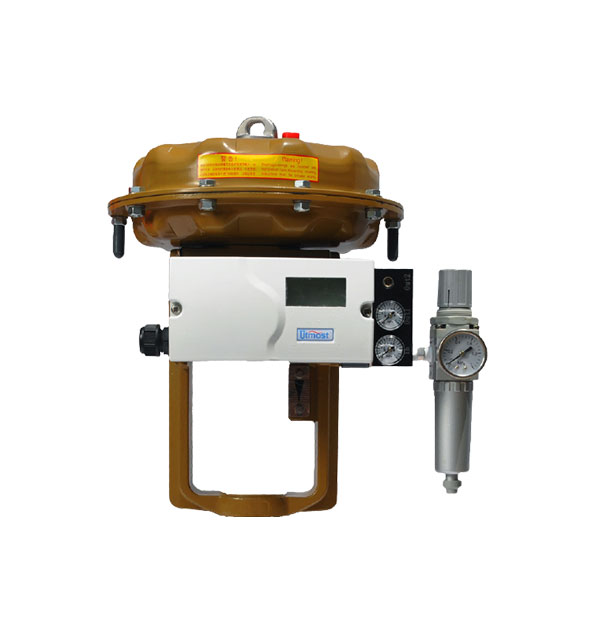Pneumatic actuator working principle refers to the use of compressed air as energy source, with cylinder as actuator, signal as driving signal, and relying on accessories such as electric valve positioner, converter, solenoid valve, and position holding valve to drive the valve and achieve linear or equal percentage flow characteristic adjustment actions, thus achieving switch or proportional adjustment of various process parameters such as flow, pressure, temperature, etc. of pipeline media. Pneumatic actuators have the advantages of simple control, fast response, and intrinsic safety, and when used in flammable and explosive situations, no additional explosion-proof measures are required.
Pneumatic actuators are usually connected and installed for commissioning with pneumatic actuators and regulating valves. In Utmost pneumatic actuator manufacturer, products can be divided into single and double acting types. Single acting actuators have reset springs, while double acting actuators do not. In a single acting actuator, the valve automatically returns to the initial opening or closing state set by the valve in case of loss of source or sudden failure. Pneumatic actuators are divided into air open and air close types according to their action mode, i.e., normally open and normally closed types. The air open or air close of the pneumatic actuator is usually achieved by the positive and negative action of the actuator and the different assembly modes of the valve state structure.

For the actuator, many people should know that it is an important device for controlling valves. The actuator is mainly divided into three categories: pneumatic, electric, and hydraulic, and each type of actuator has its own different styles, designed and developed for different occasions. Pneumatic actuators are one type of actuator.
For the selection and use of pneumatic actuators, first of all, we need to look at the functions that need to be realized. If the actuator needs to be reset after a power failure, a single-acting spring reset pneumatic actuator should be selected; if the original position can be maintained after a power failure, a double-acting pneumatic actuator should be selected. At the same time, if equipped with an air storage tank, the use of a double-acting pneumatic actuator is more convenient, and a cycle control can still be completed after a power failure.
After selecting the actuator, it depends on how to control and use it. It is recommended to configure a three-way five-way solenoid valve to control the pneumatic actuator by controlling the air flow.
In mechanical operations, pneumatic actuators play a crucial role, which requires everyone to understand the installation, commissioning, maintenance, and fault analysis of pneumatic actuators. Only with correct installation, operation and necessary maintenance, can the maintenance work of valves achieve the desired effect and application purpose.
After taking the cylinder, first check whether the cylinder model is correct, and whether the cylinder is open or closed. Generally, it is closed during installation.
Check the rotation direction of the cylinder. Rotate counterclockwise to open the valve and clockwise to close the valve.
When the cylinder is connected to the valve, check whether the center distance of the connection hole of the cylinder and the center distance of the flange connection hole on the valve are consistent.
Check whether the cylinder axis and the valve stem axis are consistent. If the axis is inconsistent, add a square sleeve.
During installation, the cylinder should have the same state as the valve (note that one cannot be open while the other is closed, otherwise the valve will rotate in the opposite direction).
Installation status: butterfly valves and actuator are installed at 90 degrees. Ball valves are installed in parallel with the actuator.